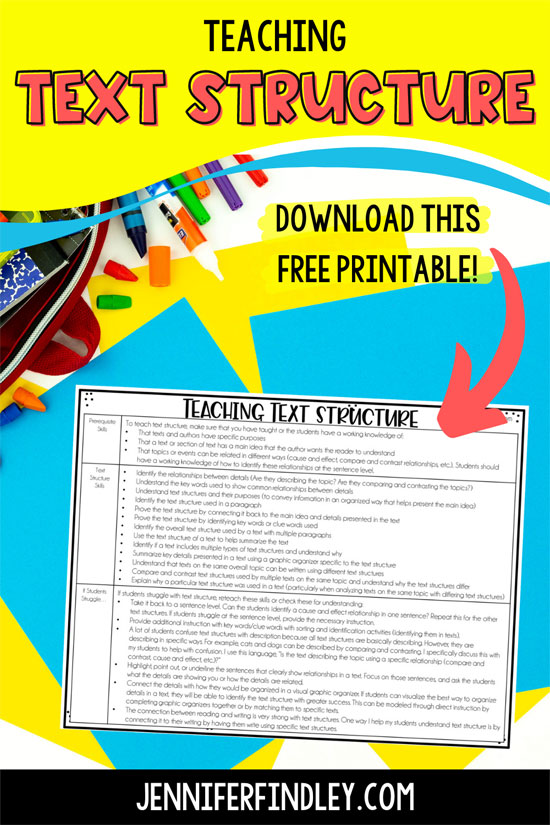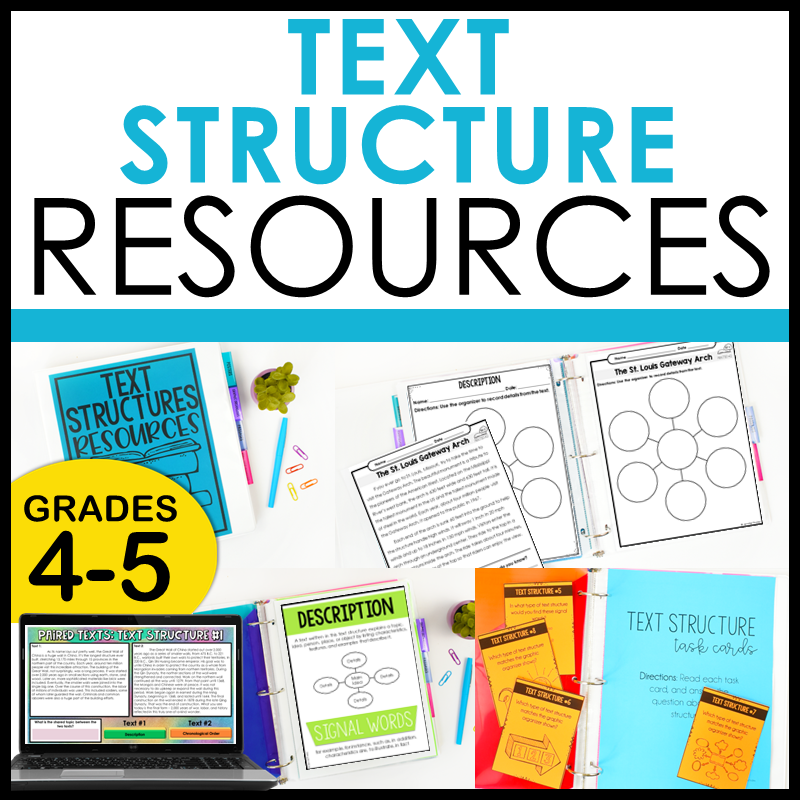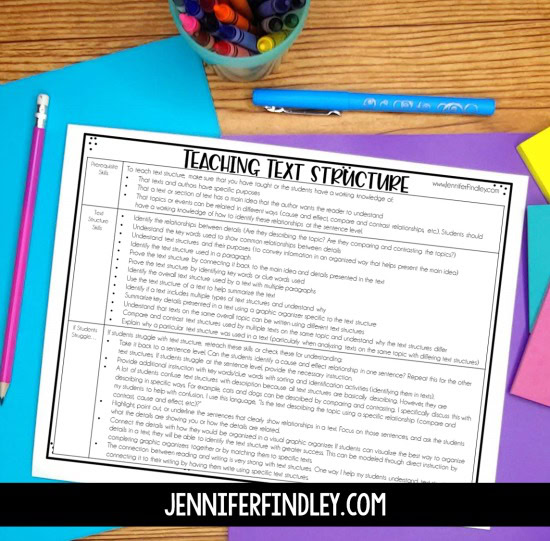Text structure is a very powerful reading skill that can really help students make sense of and analyze informational text. This post shares tips for teaching text structure, including pre-requisite skills, all the different text structure skills, and strategies for when students struggle.

What is Text Structure?
Text structure refers to how the details and information in a text are organized. There are five common types of text structure:
- Description
- Chronological Order/Sequence
- Compare and Contrast
- Problem and Solution
- Cause and Effect
When introducing text structures, I introduce them all at once and then we dive deep into specific text structures in the following days. The order above is how I traditionally sequence my teaching.
Why is Text Structure Important?
When readers identify and recognize the text structure of a text, this can significantly improve their comprehension and retention of information.
Understanding the text structure can help students:
- Organize information and details they are learning in their minds while reading
- Make connections between the details being presented in a text
- Summarize the important details shared in a text
Pre-Requisite Standards Before Teaching Text Structure
To teach text structure, make sure that you have taught or the students have a working knowledge of:
- That texts and authors have specific purposes
- That a text or section of text has a main idea that the author wants the reader to understand (The students may not be able to adequately generate or select a main idea but they need to understand that texts have these).
- That topics or events can be related in different ways (cause and effect, compare and contrast relationships, etc.). Students should have a working knowledge of how to identify these relationships at the sentence level.
Text Structure Skills Students Need to Master
Text structure skills vary from 4th to 5th grade. In 5th grade, the students are really expected to go much further than simple identification. Increasing the rigor for 4th grade students (who are ready) will plant those seeds and help them succeed in 5th grade.
5th grade teachers, on the other hand, may have to teach all of the text structure skills to get our students to the necessary rigor required (even the ones required by 4th because we know that retention is not always something that goes in our favor.)
- Identify the relationships between details (Are they describing the topic? Are they comparing and contrasting the topics?)
- Understand the key words used to show common relationships between details
- Understand text structures and their purposes (to convey information in an organized way that helps present the main idea)
- Identify the text structure used in a paragraph
- Prove the text structure by connecting it back to the main idea and details presented in the text
- Prove the text structure by identifying key words or clue words used
- Identify the overall text structure used by a text with multiple paragraphs
- Use the text structure of a text to help summarize the text
- Identify if a text includes multiple types of text structures and understand why
- Summarize key details presented in a text using a graphic organizer specific to the text structure
- Understand that texts on the same overall topic can be written using different text structures
- Compare and contrast text structures used by multiple texts on the same topic and understand why the text structures differ
- Explain why a particular text structure was used in a text (particularly when analyzing texts on the same topic with differing text structures)
Keep this list in mind when planning your whole group mini-lessons as well as your small group reading lessons. I spend two weeks teaching text structure in 5th grade (read more about my reading pacing here). If you don’t have the time to do this, I recommend teaching these skills as part of your small group reading lessons.
Tips for Students Who Struggle with Text Structure
If students struggle with text structure, reteach these skills or check these for understanding:
1. Take it back to a sentence level. Can the students identify a cause and effect relationship in one sentence? Repeat this for the other text structures. If students struggle at the sentence level, provide the necessary instruction.
2. Provide additional instruction with key words/clue words with sorting and identification activities (identifying them in texts).
3. A lot of students confuse text structures with description because all text structures are basically describing. However, they are describing in specific ways. For example, cats and dogs can be described by comparing and contrasting the two animals. I specifically discuss this with my students to help with confusion. I use this language, “Is the text describing the topic using a specific relationship (compare and contrast, cause and effect, etc.)?”
4. Highlight, point out, or underline the sentences that clearly show relationships in a text. Focus on those sentences, and ask the students what the details are showing you or how the details are related.
5. Connect the details with how they would be organized in a visual graphic organizer. If students can visualize the best way to organize details in a text, they will be able to identify the text structure with greater success. This can be modeled through direct instruction by completing graphic organizers together or by matching them to specific texts.
6. The connection between reading and writing is very strong with text structures. One way I help my students understand text structure is by connecting it to their writing by having them write using specific text structures.
Note: Basic reading comprehension of a text is required for students to understand the details and how they are related/connected. If your students cannot do this, they will likely struggle with identifying and writing about the text structure of grade level (or even approaching grade level) texts. One way to help with skill instruction is by using a lower lexile. Click here to see passages and texts written for 4th and 5th grade skills but at a 2nd/3rd grade lexile level.
Download a Printable Version
Want a one-page printable version of the tips and information for teaching text structure shared on this post? Click here on the image below to grab it!
Recommended Text Structure Resources
If you are tired of searching for activities, resources, and passages to teach text structure to your students, I highly recommend checking out my Text Structures Resource. It includes so many resources for teaching and practicing text structure that you likely won’t even be able to use them all (which is not a bad problem to have!) There are teaching posters, graphic organizers, so many texts to use (individual and paired), and small group activities. It is truly a one-stop shop for text structure activities!
Shop This Post

Text Structures Resources & Activities
Everything you need to teach text structures-- posters, graphic organizers, texts (short texts, long texts, paired texts), and small group activities, including task cards!More Text Structure Blog Posts and Freebies
Read Alouds for Teaching Text Structure
Reading Sorts – Grab a free text structure reading sort in this free set of reading sorts. They make a perfect re-teaching activity or reading center to review basic identification of text structures.
Free Text Structure Activities and Resources – Grab some free printable resources to help your students understand text structure and apply it to their own books on this post.








Leave a Comment